
Healing Fingers and Toes: 1 2 3 Next>>
Treating Fingers and Toes In the Golden Age of Piracy, Page 1

Photo: Duncan McGuyver, Crew of the Vigilant
Reenactment of Lt. Maynard and Blackbeard Battling with Swords, from
The Blackbeard Pirate Festival, 2008
"Black-beard and the Lieutenant fired the first Pistol at each other, by which the Pyrate received a Wound, and then engaged with Swords; till the Lieutenant's unluckily broke, and stepping back to cock a Pistol, Black-beard, with his Cutlash, was striking at that Instant, that one of Maynard's
Men gave him a terrible Wound in the Neck and Throat, by which the Lieutenant came off with a small Cut over his Fingers." (Captain Charles Johnson, The General History of the Pyrates, 3rd ed., p. 83-4)
Wounds of the hands and feet do not generally appear prominently in sea accounts although the digits, particularly the fingers, would have been important to the average sailor for executing his regular duties.
A variety of health issues could affect the fingers and toes, several of which were discussed in period medical books. The specific topics range widely from the simple - such as as properly cutting the nails - to the more complex - such as amputation. This article will look at these topics beginning with a brief look at examples of accounts that mention wounds to the fingers and toes and health at sea, performing humoral treatments on the digits, dealing with warts and corns, paring the nails, infections of the fingers and toes, wounds, fractures, dislocations, and amputation.
Examples of Health Concerns for Fingers and Toes
Blackbeard's slicing of Lieutenant Maynard's fingers in the above section is
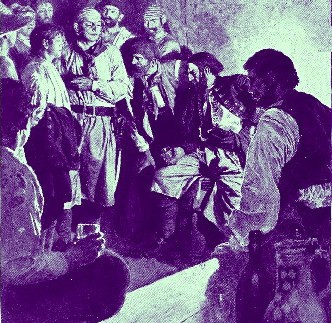
Artist: Howard Pyle
Pirates Meeting, From jack Ballister's Fortunes (1894)
one of a very few examples of digits being damaged at sea. This is probably not because it was a rare event, but because it was minor when compared to other wounds, so that they didn't often merit mentioning. A ship, with it's variety of lines (ropes), heavy, wheeled cannon carriages, blocks and tackles and rough wooden surfaces, would have provided plenty of opportunities to wound, pinch, splinter and crush fingers and toes.
Cannons could do damage, something that was described by the supercargo of an East India merchant ship when it was under attack by Robert Collover's pirates. There, "the barber’s mate [had] two fingers shott off as hee was sponging a gun."1 This emphasizes the importance of observing proper cannon loading and firing procedures.
Fingers were considered particularly important in pirate and privateer ship's articles, which set down the rules and rewards of a ship. Some articles offered compensation for the loss of fingers, although not for toes. Henry Morgan's articles offered "100 [pieces of eight] or one slave... for the loss of a finger."2 Father Jean-Baptiste Labat noted that the buccaneers offered "300 écus [a French coin] for the loss of a thumb or the first finger of the right hand, or an eye, and 100 écus for each of the other fingers."3 Captain William Kidd's 6th article promised, "That if any man shall receive a flesh wound or lose a finger or toe in the said ship or company service, he shall receive for smart money [money paid for wounds received] one hundred pieces of eight out of the whole stock before any dividend be made."4
Because the digits are sensitive, pirates had a tendency to abuse prisoner's fingers using lighted 'matches' - which
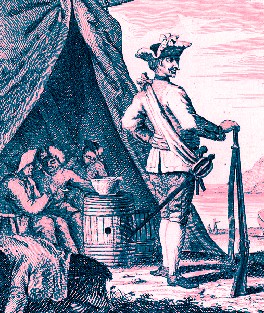
Artist: Joseph Nicholls
Capt. George Lowther, From The General History
of the
Pyrates
(1736)
were pieces of hemp cord soaked in a solution of saltpeter and lime water so that they would burn slowly. After pirate captain George Lowther's pirates captured the ship Greyhound in 1722, "[Scottish surgeon John] Crawford was singled out for torture with lighted fuses between his fingers to reveal the whereabouts of some concealed gold dust"5.
Sometimes this was done to punish men the pirates didn't like. Edward Low "took a Sloop bound to Amboy, William Frazier, Master, with whom Mr. Low happening to be displeased, he ordered lighted Matches to be ty'd between the Mens Fingers, which burnt all the Flesh off the Bones; then cut them in several Parts of their Bodies with Knives and Cutlashes afterwards took all their Provisions away, and set some of them ashore in an uninhabited Part of the Country."6
In court testimony against pirate captain Thomas Anstis' crew, surgeon William Parker deposed, "The Pirates beat me several times; they put burning Match betwixt my Fingers; and twice I was thrown Over-board"7.
Not only the pirates meted out such punishment. Pirate captain James Kelly wrote in a letter to his wife, that when their consort ship was taken by soldiers, "they seiz'd on the Ship and abused them inhumanly, in somuch that if a Man had a Ring on his Finger, they would bite the whole Finger off"8.
Naturally, these and other wounds of the digits would have had to be treated when the wounded man survived.
1 "64. The battle between the Dorrill and the Mocha", Pirates in Their Own Words, Ed Fox, ed., p. 44; 2 Alexandre Exquemelin, The Buccaneers of America, 1969, p. 71; 3 Pere Jean-Baptiste Labat, The Memoirs of Pére Labat 1693-1705, p. 37; 4 Ed Fox, Piratical Schemes and Contracts (Doctoral Dissertation), p. 311; 5 Eric J. Graham, Seawolves: Pirates & the Scots, p. 109; 6 Captain Charles Johnson, The General History of the Pyrates, 3rd ed., p. 83-4; 7 "61. Bridstock Weaver and William Ingram", Pirates in Their Own Words, Ed Fox ed., p. 326-7; 8 "A full and true Discovery of all the Robberies, Pyracies, and other Notorious Actions of that Famous English Pyrate, Capt. James Kelly", Pirates in Their Own Words, Ed Fox ed., p. 44
Humor Theory and the Hands and Feet
Humor theory was a central tenet of health care, dating to the time of Hippocrates (around 400 B.C.) all the way through the American Civil War. Humor theory proposed that the body contained a variety of humors or fluids which had to be properly balanced to create and/or maintain the health of the body. Four bodily humors were generally recognized: blood, black bile (melancholy), yellow bile (choler) and phlegm. When a patient was ill, his humors were believed to be unbalanced which had to be corrected by a variety of procedures including bleeding, cauterizing, cupping, the creation of fontanels, purging and sweating. Some of these procedures were performed on the hands and feet.
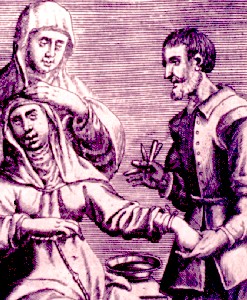
Venesection of the Hand, From Cintio d'Amato's
Nuova
et
utlilssima prattica, p. 55 (1671)
The revered Arabic physician Albucasis (Abu al-Qasim al-Zahrawi, 936 - 1013 A.D.) had much to say about bleeding the hands and feet. The influence of his work was still present during the golden age of piracy resulting in his methods being taught to surgeons and physicians.
Albucasis believed that bleeding a patient at different places on the body particularly affected other parts. For example, he explains that venesection "of the salvatella [a vein branching off from basilica near the wrist] of the right hand is efficacious in case of diseases of the liver."1 He explained that the same vein on "the left hand is of value in diseases of the spleen."2
The method he recommended for bleeding the salvatella was
to tie a band round the wrist or grip it with your hand, after you have put it in hot water until the vein is swollen up and is plainly to be felt; then cut it somewhat obliquely; if you cut it right through that will not matter at all. But be careful not to go too far with the knife, for underneath there are the tendons of the fingers and the place is bare of flesh. Then put the hand again into hot water and let the blood flow; for if you do not put it into hot water again the blood will clot in the opening and will be prevented from flowing.3
Albucasis advised that bleeding the saphena vein at the foot was "beneficial in diseases of the lower part of the body, such as afflictions of the uterus and retention
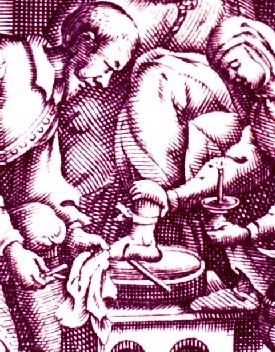
Venesection of the Foot, From Cintio d'Amato's Nuova
et
utlilssima prattica, p. 37 (1671)
of the menses, and for diseases of the kidneys, and for chronic ulcers of the hips and legs, and similar diseases."4
Now the manner of venesection is for the patient to put his foot in hot water, then friction should be applied to it until the veins fill up; then bind a thong over the joint of his foot; then the site of the vein at the ankle is shown up running toward the big toe and forming many branches on the surface of the foot. Then make your incision either in the broadest branch or at the ankle before it ramifies, for that is better and safer. If you venesect it on the surface of the foot, be careful of the tendons that are beneath on the surface of the foot. Make the incision obliquely as though you were cutting the vein through. The knife should be a lancet. If the flow of blood be impeded, put the foot back again into hot water and let the blood flow out into it until it is evacuated.5
If the saphena couldn't be easily located on the surface of the foot, Albucasis recommended that the surgeon
venesect one of its branches, which will be seen on the surface of the foot towards the fourth toe and the little toe. Be careful of the tendons, and let the amount of blood you require. Then loosen the bandage and apply cotton wool to the site of the section and bandage the place; it will heal quickly.6
Albucasis was not the only surgeon to mention humoral treatments in the hand and foot. For a patient whose hand was twitching after he had healed an inflamed tumor (referred to as a bubo) had been removed, military surgeon Richard Wiseman noted that he "made a Fontanel between the Thumb and Fore-fingers" which he said cured the problem.7 A fontanel was an incision made in the skin into which an irritant was placed (such as a pea) to cause the wound to become infected and suppurate, or form pus and leak serum. The idea was purge the bad humors from the site via this fontanel.
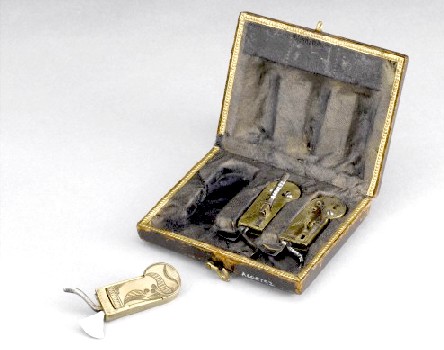
Spring Fleam Set - Wellcome Museum, London (18th - 19th c.)
Although the most straight-forward way of opening a vein would seem to have been with a blade, other methods were also used. Modern surgical instrument historian Elizabeth Bennion talks about "the single-bladed scarifier, occasionally called a Spring Fleam or Schnapper; this was invented by a German c. 1680. It was sometimes made with a curved guard, presumably for bleeding the finger"8.
Not all spring fleams were for bleeding fingers, however. In fact, Bennion notes that the original design was probably not specifically made for the finger. She also says that it may not have been in wide use during the golden age of piracy.
French surgical instructor Pierre Dionis suggested a much simpler solution for removing blood from "the Parts which cannot bear either Bleeding or Scarifications, as the Face, the Lips, the Nose, the Joints, the Fingers, and the Anus"; he used leeches. Dionis explains that, "Leaches supply the Place of Bleeding, their Sting or sharp pointed Needle performing the Office of the Lancet."9 While perhaps a bit distasteful to us, leeches would have been preferable to regular incisions in the sensitive digits.
1 M.S. Spink and G.L. Lewis, Albucasis On Surgery and Instruments; A Definitive Edition of the Arabic Text with English Translation and Commentary, 1973, p. 650; 2 Spink and Lewis, p. 652; 3 Spink and Lewis, p. 650; 4,5 Spink and Lewis, p. 652; 6 Spink and Lewis, p. 654; 7 Richard Wiseman, Eight Chirurgicall Treatises, 3rd Edition, p. 430; 8 Elizabeth Bennion, Antique Medical Instruments, p. 48; 9 Pierre Dionis, A course of chirurgical operations: demonstrated in the royal garden at Paris. 2nd ed., p. 476
Treating Warts and Corns
A problem that affects the hands and feet are warts; another problem which specifically appears on the feet are corns.
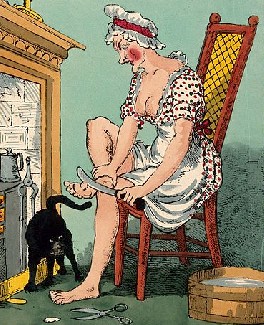
Artist: James Gilray - Cutting Corns (19thc.)
Two military surgeons from the period discussed the treatment warts and corns: English surgeon Richard Wiseman and German surgeon Matthias Gottfried Purmann.
While the sea surgeon authors from this period do not specifically mention either of these problems in detail, they were likely common problems among seamen. Corns (and the related calluses) are caused by pressure and friction on the feet and repeated actions; ill-fitting shoes and use of hand tools are common suspects in their creation1. These are things many foremast sailors would have encountered. Warts are caused by the human papillomavirus entering scratches in the skin2. Scratched feet, and particularly scratched hands, are likely to have been a part of most seamen's lives.
Of course, period surgeons didn't have scientific studies to explain where warts and corns came from, so they had their own theories about the origins of such things, parts of which may sound a bit quaint to us today. Purmann explains, "In substance and Matter they [corns] appear to be the same with Warts, only Corns are more hard and compact, which proceeds from being continually crush’d by Shoe in Walking; which otherwise without all doubt would have been nothing else than Warts."3
Wiseman similarly suggests they are both skin tumors with one essential difference.
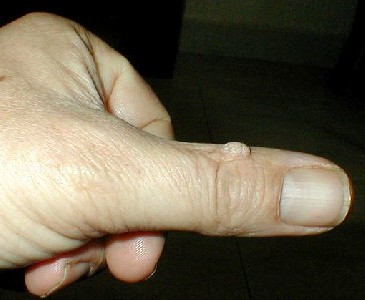
Photo: Lucien Mahin - A Wart on the Thumb
The wart "beginneth in the Cutis, and seemeth to be either an efflorescence [eruption of the skin] of the Serum of the Bloud, which, hardning in the surface of the Skin, maketh a dry Tumour"4. He said that a corn "beginneth in the Cuticula with its basis outward, owing its origin to an outward Compression, and thence derives it self inward into the Skin, nay, often through it to the Membranes, Tendons,&: Cartilages, to which it frequently unites it self, to the no small disturbance of the Patient."5 Similar to the Mayo Clinic, Wiseman explains that corns "groweth in any part that is liable to great pressure; the Toes and Feet, the Lips of Trumpetters, the Ears of Ladies &c."6.
In advising on how to cure such problems, Wiseman notes that "Warts do often fall away of themselves"7. However, he also suggests that there are a large number of methods which can be used to cure them - from medicines to lancing.
Those [medicines] which are most easie to be had in the Country are, the green Rinds of Willows beaten, the Juice of Marigolds, Celandine, all the Spurges, a Garden snail sprinkled with Salt. If you rub them with any of these, they will fall off. Ol. vitrioli or ol. sulphuris will certainly destroy them. I have seen some burn them out by running a hot Needle into the root of them. There are other ways, as by rubbing them with raw Beef, and burying it. But when any great one falls into my hands, I make a speedier riddance of it by Ligature [tying a string around it] or Caustick [burning it with a caustic stone - referred to as using a 'potential cautery']. Where it is capable of being tied, I make a Ligature: in others, where it is not, the Caustick-stone alone will do it.8
For corns, Wiseman suggests cutting them off, "and applying red soft Wax".
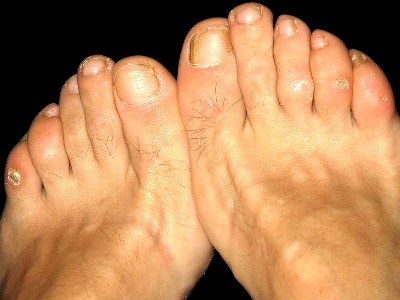
Photo: Wiki user Marionette - Corns on the Feet
Failing that, he gives a recipe for two compound medicines. The first contains naval pitch, diachylon plaster, galbanum dissolved in vinegar and ammonium chloride. The other has alum, vitriol and orpiment (arsenic sulfide metal) mixed in vinegar in it.9
Purmann lists a variety of different medicines for treating corns (and apparently warts). However, his basic recommendation is to use a compound balsam containing lead oxide, oil of almonds (probably bitter), zinc oxide, balsam of Peru, opium and myrrh mixed into a balsam with oil of hyperion.
This balsam is to be applied "with double Linen Rags, [and with] the following Water [made] very warm, over the Lint and Balsam, and the whole Foot." The 'Water' he mentions contains white earth, zinc oxide, sugar of lead, comphora, myrrh, ammonium chloride, burnt alum, frankincense, and spirit of wine cooked in quicklime and then mixed with plantane water and water of elder flowers, and aq. Cherefol [probably distilled water of Cynoglossum cheirifolium plants].10
Purmann explains, "If the ill Accidents have not prevailed too far, you may be well assured, that these two Medicines will perfectly reduce them into good order again"11.
1 "Diseases and Conditions: Corns and Calluses", www.mayoclinic.org, gathered 5/16/16; 2 "Diseases and Conditions: Common Warts", www.mayoclinic.org, gathered 5/16/16; 3 Matthias Gottfried Purmann, Churgia Curiosa, 1706, p. 309; 4,5,6 Richard Wiseman, Of Wounds, Severall Chirurgicall Treatises, 1676, p. 95; 7,8,9 Wiseman, p. 96; 10 Purmann, p. 309; 11 Purmann, p. 310
Cutting Nails
Only German military surgeon Matthias Gottfried Purmann has anything of significance to say about paring the finger and toe nails.
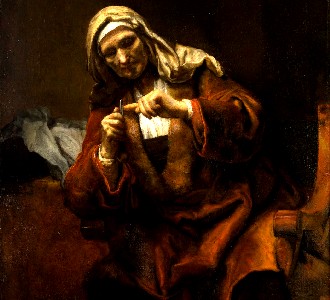
Artist: Rembrandt - Woman Cutting Her Nails (1658)
Even he begins by saying, "I know some will little value what can be said on this subject", but he quickly points out that such people "only proclaim their own Ignorance of the Dangers which attend the ill management of those parts".1 He further chides his readers on the topic, noting that he knew two men "who were both snatch’d away by painful and miserable deaths, which happened by the paring of their Nails."2
Purmann cautions that during "cutting of Nails, if not prudently and Cautiously done, the small Fibræ and Vessels are so tender, that if they are never so little hurt, they often cause violent Inflammations, Gangrenes and Death"3.
After all this build-up, he only mentions that he uses a knife to cut nails, emphasizing that he does so carefully. Not wanting to miss an opportunity to emphasize the potential danger inherent in paring nails, Purmann finishes by advising the surgeon to use "all the care and Caution imaginable; for if a seeming slight hurt should happen and but upon one Toe, you will scarce be able to prevent it from infecting all the rest, to the peril of the whole Foot and Leg also."4
However, this topic does give me an opportunity to include a genuine Rembrant in the text, a luxury not often available to someone writing about golden age of piracy medicine.
1,2 Matthias Gottfried Purmann, Churgia Curiosa, 1706, p. 308; 3 Purmann, p. 308-9; 4 Purmann, p. 309

